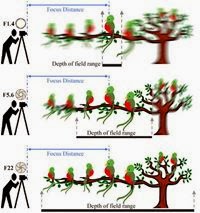Depth
of field is used to control the overall impression of sharpness in a picture.
The term means the distance between the nearest and furthest points in a scene
that show acceptably sharp focus. The key word is ‘acceptably’ for although depth of field is measured infinite terms
and is shown as such on most lenses. It is really a subjective assessment. The
extent of sharp focus varies according to the factors; the aperture selected,
the focal length of the lens and the focus setting.
Understanding
the 'reasonably sharp' concept...
 |
| Ranges of DOF |
Note
that although the focus distance remains the same in all 3 instances...the
range of sharpness before and after the focus point changes with a change in
aperture.
Depth
of field extends about one third in front of and two third behind the point of
true focus. Controlling depth of field can have a dramatic effect on
composition, particularly with subjects containing both near and distance
objects.
A
shallow depth of field throws a background out of focus, making the main
subject stand out.
Subjects
that have little dimensional depth; such as a façades of buildings or
landscapes that concentrate on very distant views, show very little visual
change as depth of field is altered.
Apertures – those with large f numbers such as
22 – give extensive depth of field, while large apertures
– those with small f numbers such as f 2.8 – limit depth of field.
When
dealing with Depth of field, you will have to consider the following:
Lens aperture:
changing the aperture is the prime depth means of altering depth of field.
Point of Focus:
the point of focus also affects the extent of depth of field with a constant f
stop setting, it can be seen that depth of field is greatest with distant focus
setting and smallest with near focus setting.
Focal length:
Depth of field is affected by focal length. At a same focus and aperture
settings, different focal length lenses give different amounts of depth of
field – wide angle lenses have the most extensive depth of field at a given
setting, while long focus lenses give the shallowest.
 |
| Shallow DOP(Photo Credit; Kwaku David) |
Hyper focal distance:
With photographs that need extensive depth of field such as a landscape with
important feature, both near and far away. The best approach is not to focus on
infinity, but to focus on a focal distance. This setting gives the maximum
possible depth of field.
 |
| Deep DOP (Photo Credit: Kwaku David) |
©
2014 Copyright Esenam’s Blog. All Rights Reserved.



